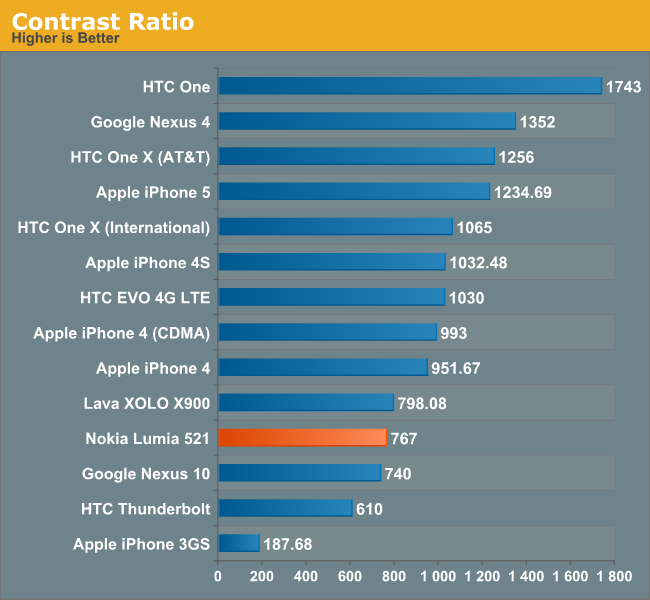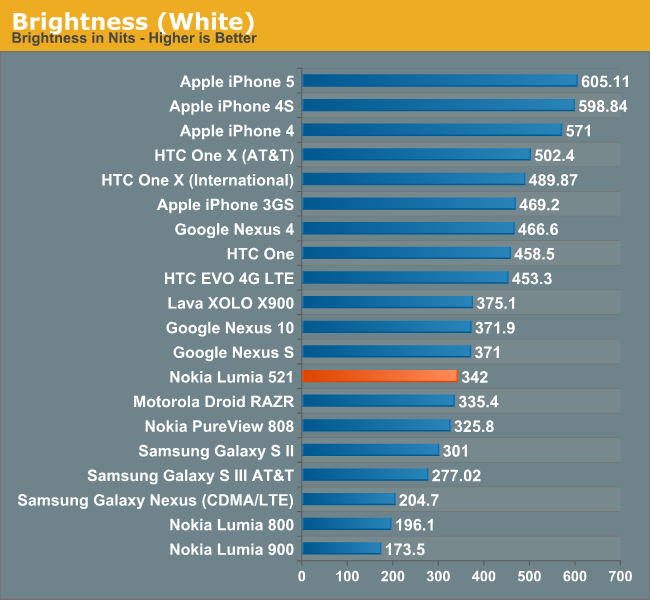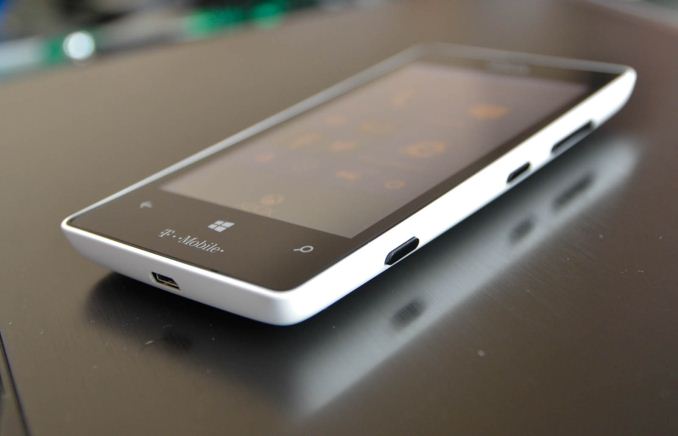Nokia Lumia 521: Quality Smartphone on an Extreme Budget
by Vivek Gowri on August 8, 2013 1:08 AM EST- Posted in
- Smartphones
- Nokia
- Mobile
- windows phone 8
- Lumia 520
- Lumia 521
I was surprised to see that the 521 (and 520) had an IPS display when the specs were finalized, because I fully expected the display to be one of the biggest sacrifices made for the sake of the budget. I suppose it’s not too much of a surprise, given that the 620 has quite a good display.
In person, the 521 display is pretty middling. It’s not a bad panel, but it’s not that fantastic either. Maximum brightness isn’t that great at 342 nits—that’s decent enough for most situations though not quite bright enough for comfortable viewing in broad daylight. The black levels aren’t anything to write home about either, so contrast ratio is pretty low by the standards of the phones we typically look at, though its worth pointing out that we focus primarily on far higher end smartphone hardware. Compared to a contrast ratio chart from a couple of years ago, the 521 is about average. The white point of 6336K is very close to neutral, and color reproduction is pretty solid as well.


 What kind of kills the 521 display experience though isn’t the panel itself, since that’s pretty decent; it’s the gap between the LCD and the glass. That turns what would be a very respectable viewing experience into an ultra reflective mess anytime you venture outdoors. As a result, you end up wanting to crank the display brightness higher than normal (which is why I rarely used the automatic brightness setting). The extra glare brought on by the air gap is rather distracting and ends up being quite the downer in a lot more usage scenarios than just outdoor. In office-style overhead lighting, too, the glare can be quite terrible and generally ends up degrading display quality by a noticeable amount.
What kind of kills the 521 display experience though isn’t the panel itself, since that’s pretty decent; it’s the gap between the LCD and the glass. That turns what would be a very respectable viewing experience into an ultra reflective mess anytime you venture outdoors. As a result, you end up wanting to crank the display brightness higher than normal (which is why I rarely used the automatic brightness setting). The extra glare brought on by the air gap is rather distracting and ends up being quite the downer in a lot more usage scenarios than just outdoor. In office-style overhead lighting, too, the glare can be quite terrible and generally ends up degrading display quality by a noticeable amount.
 Given the price point, it’s hard to fault the 521 too much and I must admit that I have somewhat of a skewed perspective. When you’re used to carrying a One, an S4, or another device with a screen of that caliber, the step down to a far lower quality WVGA panel seems pretty drastic. But the colors are vibrant, viewing angles are predictably stellar, and overall the panel looks pretty good, so there are a lot of positives to focus on.
Given the price point, it’s hard to fault the 521 too much and I must admit that I have somewhat of a skewed perspective. When you’re used to carrying a One, an S4, or another device with a screen of that caliber, the step down to a far lower quality WVGA panel seems pretty drastic. But the colors are vibrant, viewing angles are predictably stellar, and overall the panel looks pretty good, so there are a lot of positives to focus on.
The brightness controls for Windows Phone are a bit finicky—you only get four options: low, medium, high, and automatic. The brightness steps are pretty reasonable, starting with low at 74 nits, medium at 191 nits, and high at 342 nits. There is no iOS or Android style brightness slider, so you’re basically stuck trusting the light sensor or one of the three presets.










116 Comments
View All Comments
Gunbuster - Thursday, August 8, 2013 - link
This may be down to confusion on how to "re-open" an app. If you long press the back arrow capacitive button you get the running apps and have almost no lag. If you hit windows and select the live tile for an already open app it kills that app and loads it again fresh. I don't really agree with that design choice as it seems to confuse most users.Myrandex - Thursday, August 8, 2013 - link
You can hit the start button, go back to the homescreen, and select an app and still get fast refresh. It still needs to be recently run though. I do this frequently.Collin5 - Thursday, August 8, 2013 - link
It seems unlikely that Vivek doesn't know about the task switcher, but who knows?However, not all apps are reloaded when relaunched from a live tile. Some apps support a feature called "fast resume", which allows them to resume instantly, even when reactivated via a live tile. Unfortunately, apps must support this feature explicitly, and the fact that not all do leads to behavioural inconsistencies, which is why I agree with you (and Vivek) that at least this aspect of WP multitasking is poorly designed. Fast resume support must be mandatory.
althaz - Thursday, August 8, 2013 - link
This is the same behaviour as iPhone and Android (disclaimer: I haven't used an iPhone for over a year).Azurael - Friday, August 9, 2013 - link
I was about to say I very rarely encounter this issue on my phone, but then I remembered that the Nexus 4 has 2GB of RAM so it's not exactly an Apples to Apples comparison. I usually have to run 10+ apps to start seeing the reload on taskswitch behaviour...Android, however, doesn't relaunch apps if you select them from the home screen - the behaviour is exactly the same (and instant, if the app has already been launched) as using the task switcher.
I guess the biggest difference in reality is that - at least in theory - Android 4.x devices should have a task switcher button, which is a lot more obvious to the user than holding back. Having said that, a lot of 'three button' Android devices are stuck with an obsolete and practically useless menu button instead due to pigheaded device manufacturers ignoring Google's UI guidelines, and then we're stuck with the same behaviour but holding the home button instead...
Seurahepo - Friday, August 9, 2013 - link
No, it is NOT. iPhone apps are not "reactivated" when launched from the home screen. No matter how the user comes back to an app it is instant (provided it has been recently used and it is still in memory).Could some of you WP fans explain to me *why* the apps are slowly restarted from the live titles? Blaming the users are using the phone wrong is kind of defensive, seems like there is a big UI/UX problem for no apparent reason.
althaz - Thursday, August 8, 2013 - link
This is entirely dependent on the app devs actually. Most do choose to reload the app if you go back to the start screen and then load the app.Impulses - Friday, August 9, 2013 - link
That's madness... Because people who are new to smartphones tend to ignore quicker methods of multi-tasking and usually resort to tapping home and reopening apps from shortcuts/tiles/all apps...At least that's what I've observed among older clients and family members of mine, regardless of OS. If they're on an iPhone they'll seldom double tap home (if they even know about it) and on Android they flat out ignore the app switching button (a decision reinforced by HTC's choice to eliminate it I imagine, or hide it behind multiple home taps rather).
toraji - Friday, August 9, 2013 - link
good points collinmi1stormilst - Thursday, August 8, 2013 - link
I just picked up one on Craigs List for $115 new in the box (from HSN deal). It came with a cheap pair of headphones, car charger and a soft case. I charged it up and went to the t-mobile website to sign up for the $30.00 a month pre-paid plan (100 mins of talk time, unlimited text and data). I am using it as a home phone and a phone for my two youngest kids to share when they are away from home. We all like the physical phone, camera is decent (needs a flash) and the interface is clean and fun. The speed of the OS is mostly snappy the data connection is faster than expected. Battery life is more than acceptable if you are not playing and staring at it all day. I only have two complaints: 1.) The OS does seem to slow down occasionally in different screens especially when trying to type in the keyboard. 2.) It is not clear how to close down apps or navigate in the Browser. I am satisfied with the phone overall and have recommended it to budget minded folks.